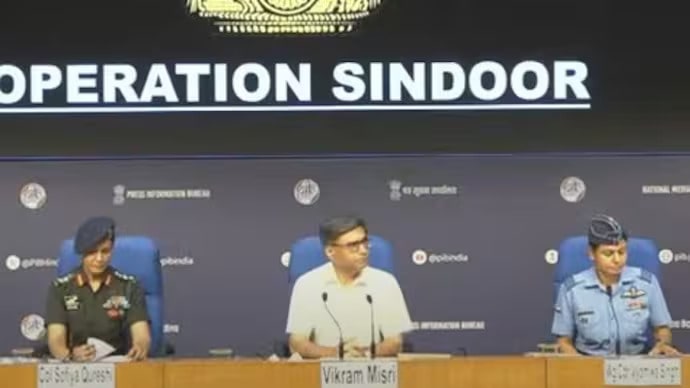

In the digital age, warfare transcends traditional battlegrounds. Alongside military operations, a fierce information war is being fought online.
Following the Indian Armed Forces’ precise and strategic action under Operation SINDOOR, India found itself targeted by an aggressive propaganda campaign launched by Pakistan. The aim: to distort the truth, mislead the global public, and reclaim lost narrative ground through a storm of misinformation.
However, India is proactively responding and dissipating misinformation with facts, transparency and is showcasing strong digital vigilance.
*Pakistan’s Propaganda*
In the aftermath of Operation SINDOOR, Pakistan responded not just with diplomatic rhetoric but with a deluge of misinformation.
*This included:*
*Recycled media:* Old photographs and videos were misrepresented as recent, combat-related content.
*Fabricated victories:* False claims of Indian losses, including downed jets and captured soldiers, were circulated without any factual basis. Even Pakistani media amplified these false losses continuously across channels.
*Government complicity:* High-ranking Pakistani officials, including ministers, promoted unverified and doctored content on social media.
*India’s Response:* Fact, Not Fiction
India has responded to this information assault with a firm, evidence-based strategy rooted in transparency and accountability.
Real-Time Fact-Checking
India has been swiftly debunking viral claims with visual evidence and source tracing with a dedicated team.
*Their timely interventions have helped:*
Clarifying origins of misleading videos
Confirming real dates and context of recycled images
Publicly counter false narratives with verifiable data*
A video was circulated with the claim that the Pakistan Air Force targeted the Srinagar airbase. In reality, this footage was traced back to sectarian clashes in Khyber Pakhtunkhwa, Pakistan, that occurred in early 2024. The video had no connection to Kashmir or any recent airstrike.-https://x.com/PIBFactCheck/status/1919916769403134126
A separate rumor claimed that Pakistan destroyed an Indian Brigade Headquarters, a claim that has no basis in fact and has been entirely fabricated, according to defense sources.- https://x.com/PIBFactCheck/status/1919922375069409298
Additionally an old image of a MiG-29 crash in Barmer, Rajasthan, from September 2024 was recirculated by pro-Pakistan social media handles to imply recent Indian Air Force losses, which did not occur.- https://x.com/PIBFactCheck/status/1919973596665135471
Such tactics are part of a broader psychological operation aimed at creating confusion, demoralizing the public, and shaping global opinion in Pakistan's favor.
Strategic Communications
The Indian defense front through coordinated press briefings and verified digital handles, has maintained a consistent flow of accurate updates to avoid narrative vacuums that could be exploited. So far, 2 press briefings have taken place to inform the public about Operation SINDOOR and relevant updates.
*Digital Vigilance and Public Awareness*
The Indian public has shown increasing awareness and skepticism toward viral content.
Prominent Indian digital influencers
and defense analysts have played a role in amplifying fact-checks and exposing coordinated attempts at disinformation.
Exposing the Weakness Behind the Noise
India’s counter-propaganda campaign has gone beyond refutation, it is also revealing the systemic flaws in Pakistan’s military infrastructure that the disinformation is designed to obscure.
The campaign highlights how Pakistan’s military, often postured as a formidable force, functioned more like a corporate buyer of foreign weapons than a coherent warfighting machine. During the Operation SINDOOR strike:
The Chinese-built HQ-9 batteries failed to detect or intercept India’s stealthy SCALP missiles, which struck targets deep in Bahawalpur and Muridke.
Command-and-control centers exhibited no real-time battlefield response throughout the 25-minute operation.
PL-15 air-to-air missiles misfired against Indian Su-30MKIs, revealing the poor integration of imported systems with Pakistan’s existing defense infrastructure.
Instead of decisive leadership, Pakistani Army generals merely reacted to alerts, behaving more like office managers checking spreadsheets than commanders directing active engagements.
This exposure of strategic inertia and technological vulnerability sharply contrasts with the narratives Pakistan tried to sell online. The campaign thus not only counters disinformation but reframes the story around Pakistan’s overreliance on untested imports and outdated tactics in modern warfare.
Shaping the Narrative with Credibility
Rather than reacting emotionally, India has taken a composed and methodical approach to information warfare:
*Highlighting operational success:* Operation SINDOOR’s effectiveness was communicated with precision, focusing on strategic outcomes rather than sensationalism.
Discrediting propaganda sources: Indian authorities have exposed the manipulation tactics used by Pakistan-based accounts, many of which are now under scrutiny by international social media platforms.
Promoting media literacy: Campaigns to educate citizens on how to identify fake news have helped create a more resilient digital environment.
*Conclusion:*
The Truth as a Strategic Asset
India's battle against propaganda is a testament to the country's maturity in handling hybrid warfare. By countering false information with facts and remaining rooted in credible communication, India has not only defended its territorial sovereignty but also upheld the integrity of information. In an era where perception can shape policy and panic can spread with a tweet, India's ability to expose and neutralize misinformation is as vital as its ability to win on the battlefield.
